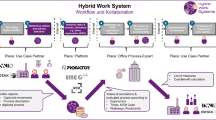Abstract
In this paper, we first investigate a semi-automated automotive engine assembly line in which the traditional strategy of using fixed workers in each manual assembly section is replaced by a new strategy of using walking workers. With this approach, both worker and engine travel simultaneously down the line; each worker is previously trained to accomplish a series of assembly tasks independently from start to finish in each manual assembly section. The study has shown great improvement of the overall system performance in terms of flexibility, efficiency, responsiveness and re-configurability using dynamic, flexible and skilled walking workers. Nevertheless, the main problem of this design is that each worker needs to be cross-trained to acquire a satisfactory level of skills associated with the assignment of assembly tasks. This is crucial for achieving a relatively even working speed at which each worker assembles a product down the line without major interruption between two adjacent workstations. In theory, the familiar degree of completing assigned tasks by each worker through training can be measured and expressed as a learning curve. In this case, the learning curve has been used to determine a trade-off decision between the complexity of assigned tasks and the duration of completing these tasks by a walking worker at a stabilised level. It has also been used to investigate the impact of the system variation that may affect the performance of individual walking workers through a learning process. Thus, the paper also describes a framework to assess the human performance by modelling the learning curve for each walking worker based in an integrated model. This model was created using a simulation tool Witness with its key input/output data manipulated externally by a series of Microsoft Excel worksheets incorporating the effect of a number of human factors in terms of cognitive and physical elements. With this method, the possible and realistic assignment of selected assembly tasks for each walking worker can be quantified.
Similar content being viewed by others
References
Bley H, Reninhart G, Seliger G, Bernardi M, Korne T (2004) Application human involvement in assembly and disassembly keynote paper. Annals of the CIRP 53:1–23
Shih H, Chiang Y, Hsu C (2006) Can high performance work systems really lead to better performance? Int J Manpow 27:741–763
Hopp WJ, Tekin E, Van-Oyen MP (2004) Benefits of skill chaining in serial production lines with cross-trained workers. Manag Sci 50:83–98
Wirojanagud P, Gel ES, Fowler JW, Cardy R (2007) Modeling inherent worker differences for workforce planning. Int J Prod Res 45:525–553
Sayin S, Karabati S (2007) Assigning cross-trained workers to departments: a two-stage optimization model to maximize utility. Eur J Oper Res 176:1643–1658
Yue H, Slomp J, Molleman E, Van-Der-Zee DJ (2008) Worker flexibility in a parallel dual resource constrained job shop. Int J Prod Res 46:451–467
Ladbrook J, Tjahjono B, Oakes E, Sales RRD, de Rueda AG, Lizarazu U, Temple C (2011) Simulation study for investment decisions on the EcoBoost camshaft machining line. Proceedings of the Institution of Mechanical Engineering Part B-Journal of Engineering manufacture 225:2124–2137
Yazgan HR, Beypinar I, Boran S, Ocak C (2011) A new algorithm and multi-response Taguchi method to solve line balancing problem in an automotive industry. Int J Adv Manuf Technol 57:379–392
Baines TS, Asch R, Hadfield L, Mason JP, Fletcher S, Kay JM (2005) Towards a theoretical framework for human performance modeling within manufacturing systems design. Simulation Modeling Practice and Theory 13:486–504
McCreery JK, Krajewski LJ, Leong GK, Ward PT (2004) Performance implications of assembly work teams. J Oper Manag 22:387–412
McCreery JK, Krajewski LJ (1999) Improving performance using workforce flexibility in an assembly environment with learning and forgetting effects. Int J Prod Res 37:2031–2058
Vits J, Gelders L (2002) Performance improvement theory. Int J Prod Econ 77:285–298
Smunt TL, Watts CA (2003) Improving operations planning with learning curves: overcoming the pitfalls of ‘messy’ shop floor data. J Oper Manag 21:93–107
Anzanello MJ, Fogliatto FS (2007) Learning curve modeling of work assignment in mass customized assembly lines. Int J Prod Res 45:2919–2938
Howick S, Eden C (2007) Learning in disrupted projects: on the nature of corporate and personal learning. Int J Prod Res 45:2775–2797
Adler PS, Clark KB (1991) Behind the learning curve: a sketch of the learning process. Manag Sci 37:267–281
Finch BJ, Luebbe R (1995) The impact of learning rate and constraints on production line performance. Int J Prod Res 33:631–642
Wang Q, Lassalle S, Mileham AR, Owen GW (2009) Analysis of a linear walking worker line using a combination of computer simulation and mathematical modeling approaches. J Manuf Syst 28:64–70
Author information
Authors and Affiliations
Corresponding author
Rights and permissions
About this article
Cite this article
Wang, Q., Sowden, M. & Mileham, A.R. Modelling human performance within an automotive engine assembly line. Int J Adv Manuf Technol 68, 141–148 (2013). https://doi.org/10.1007/s00170-012-4714-y
Received:
Accepted:
Published:
Issue Date:
DOI: https://doi.org/10.1007/s00170-012-4714-y




